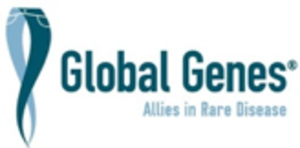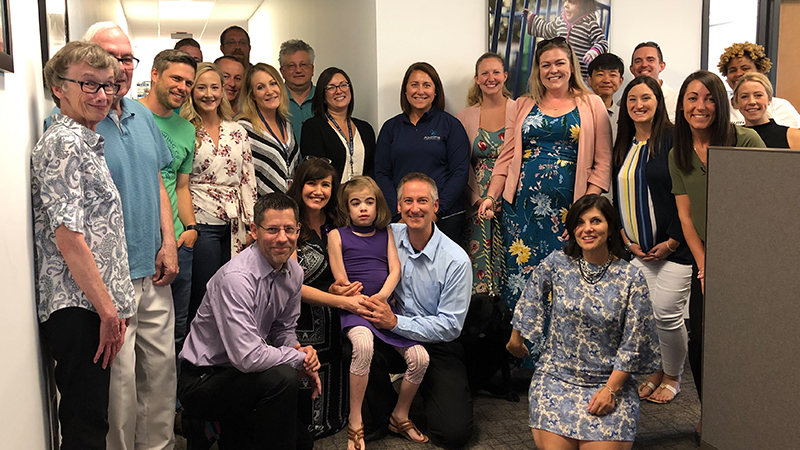Patients & Families
Living Life with RDEB
Geovanna and Noelle live on opposite sides of the world but they share a similar life filled with courage in the face of debilitating pain. This is a story of hope and resilience among families living with RDEB.
Our focus
Rare Genetic Diseases
There are an estimated 7,000 rare diseases, each affecting fewer than 200,000 people in the U.S. These relatively small groups of patients collectively total more than 25 million Americans, but the breadth and devastation of rare disease is far greater, with children representing about 50% of people living with a rare disease and rare diseases accounting for 35% of deaths in the first year of life. The nature and progression of many rare diseases are poorly understood and likely responsible for the significant need for treatments, with less than 5% of all rare diseases having approved therapies.
However, gene therapy is rapidly gaining momentum, considering 80% of rare diseases are caused by an inherited genetic defect. Gene therapy aims to address the true underlying cause of a disease, and may involve repairing, replacing, or silencing a broken, malfunctioning, overactive, or missing gene. While the durability of gene therapy is unknown, they are designed to treat patients our only one time to slow, halt, or reverse the effects of these diseases. Some of these new approaches use a neutralized virus to deliver a functional copy of a mutated gene.
Recessive Dystrophic Epidermolysis Bullosa
Recessive Dystrophic Epidermolysis Bullosa, or RDEB, is a rare connective tissue disorder without an approved therapy in which patients suffer with severe epidermal wounds that bring pain, itching, and widespread complications impacting the length and quality of their lives.
People with RDEB have a defect in the COL7A1 gene, leaving them unable to produce Type VII collagen that helps anchor the dermal and epidermal layers of the skin.
The lack of Type VII collagen results in severe and chronic blistering, open and painful wounds, and severe impact on internal organs, among other symptoms. These wounds typically remain unhealed for months to years and can cover a large percentage of the body. The challenges of living with RDEB are also complicated by the high risk of developing an aggressive form of skin cancer known as squamous cell carcinoma.
Without an approved therapy, RDEB care is currently limited to bandaging wounds, which must be done frequently to avoid infection. While costs vary based on the type and number of bandages, and wound size, the average cost of bandages for a 10-year-old child is approximately $120,000 per year.
Abeona is developing an autologous, gene-corrected cell therapy for RDEB. We expect to initiate the pivotal Phase 3 VIITAL™ study evaluating EB-101 for the treatment of RDEB in Q1 2020. Learn more about The VIITAL Study™.
Resources
Rare Genetic Diseases
With the mission to eliminate the challenges of rare and genetic diseases, Global Genes raises awareness, provides public and physician education, builds community support through social media, and funds research to find treatments and cures.
The EveryLife Foundation is dedicated to advancing the development of treatment and diagnostic opportunities for rare disease patients through science-driven public policy. The foundation provides the training, education, resources and opportunities to make your voices heard. By activating the patient advocate, the organization can change public policy and save lives.
NORD is a patient advocacy organization dedicated to individuals with rare diseases and the organizations that serve them. NORD, along with its more than 280 patient organization members, is committed to the identification, treatment and cure of rare disorders through programs of education, advocacy, research and patient services.
iCAN is a worldwide consortium of children’s advisory groups, known as Kids Impacting Disease Through Science (KIDS) and Young Persons Advisory Groups (YPAGS). These dedicated youth member groups work in unison around the world to provide a voice for children and families in medicine, research, and innovation.
GARD is a program of the National Center for Advancing Translational Sciences (NCATS) and funded by two parts of the National Institutes of Health (NIH): NCATS and the National Human Genome Research Institute (NHGRI). GARD provides the public with access to current, reliable, and easy-to-understand information about rare or genetic diseases in English or Spanish.
CORD is Canada’s national network for organizations representing all those with rare disorders. The organization provides a strong common voice to advocate for health policy and a healthcare system that works for those with rare disorders. CORD works with governments, researchers, clinicians and industry to promote research, diagnosis, treatment and services for all rare disorders in Canada.
EURORDIS is a unique, non-profit alliance of 869 rare disease patient organizations from 71 countries that work together to improve the lives of the 30 million people living with a rare disease in Europe.
Orphanet is a unique resource, gathering and improving knowledge on rare diseases so as to improve the diagnosis, care and treatment of patients with rare diseases. It aims to provide high-quality information on rare diseases and ensure equal access to knowledge for all stakeholders. Orphanet also maintains the Orphanet rare disease nomenclature (ORPHAnumber), essential in improving the visibility of rare diseases in health and research information systems.
This public organization’s mission is to help people with rare diseases by contributing to the search for methods of diagnosis and treatment of rare diseases; to promote the implementation of the constitutional rights of patients with rare diseases in the Russian Federation; and to help patients with rare diseases. For 7 years now, it has been communicating daily with orphan patients, helping to solve many of the special problems that the disease poses to a person.
The ARM Foundation for Cell and Gene Medicine is dedicated to providing the education, information, and research needed to accelerate patient awareness of and access to transformative therapies.
The American Society of Gene & Cell Therapy is the primary professional membership organization for gene and cell therapy. The mission of ASGCT is to advance knowledge, awareness, and education leading to the discovery and clinical application of genetic and cellular therapies to alleviate human disease.
NCATS was established to transform the translational science process so that new treatments and cures for disease can be delivered to patients faster. As one of 27 Institutes and Centers (ICs) at NIH, NCATS strives to develop innovations to reduce, remove or bypass costly and time-consuming bottlenecks in the translational research pipeline in an effort to speed the delivery of new drugs, diagnostics and medical devices to patients.
Genetic Alliance engages individuals, families, and communities to transform health. The organization is resolute that people come first. It partners with individuals and communities to transform health systems to respond to what people most need.
Accelerating diagnosis and treatment options for patients with rare diseases through public-private partnerships, advocating for mandatory newborn screening. Public Policy development/implementation to cover rare, undiagnosed and genetic diseases patients in India. Such as Rare Disease Policy and Orphan Drug Policy. Connecting 70+ million patients with any of 7000+ diseases in India in collaboration with international Consortia such as IRDiRC, UDN, ICORD etc. Organizing national and international conferences to bring all stakeholders of rare diseases together for debates and discussions. Facilitate & encourage research & Orphan drug development activities.
CPN is a destination created by families, for families, to support and strengthen them as they care for very sick children. Here you will find wisdom from fellow parents who understand, as well as resources developed by experts to help you cope and get through each moment.
A service of the National Library of Medicine, provides access to over 12 million MEDLINE citations back to the mid-1960's and additional life science journals. PubMed includes links to many sites providing full text articles and other related resources.
Epidermolysis Bullosa
United States
The Dystrophic Epidermolysis Bullosa Research Association of America (debra of America) is the only U.S. nonprofit providing all-inclusive support to the EB Community, through funding research for a cure and by providing free programs and services for those with: Epidermolysis Bullosa (EB) — "The Worst Disease You've Never Heard Of."
The Epidermolysis Bullosa Medical Research Foundation was established in 1991 by Gary & Lynn Fechser Anderson at the request of Dr. Eugene Bauer, then Professor and Chairman of the Department of Dermatology at The Stanford University School of Medicine. His research team was making exciting progress of their study of EB but needed additional funding to realize their goals.
The Andersons lost two children, Chuck and Christine, to Epidermolysis Bullosa. Both children suffered deformities of the hands and feet, chronic anemia, malnutrition and growth retardation. Neither child ever weighed more than 84 pounds. The worst part of the disease was their constant pain.
The EBMRF is unique in that the Foundation pays no salaries. All work, including executive, development and administrative, is done on a volunteer basis. The Foundation prides itself on its efficiency, keeping operating costs at less than 1% of incoming donations so that a full 99% of contributions can go directly to our research programs.
The EB Research Partnership is the largest nonprofit dedicated to funding research aimed at treating and ultimately curing Epidermolysis Bullosa (EB), a group of devastating and life-threatening genetic skin disorders that affect children from birth.
We are working to treat and cure EB as quickly and efficiently as possible. We fulfill our mission by partnering with non-profit and for-profit organizations, foundations, individual donors, and the EB and research communities.
Leading researchers say treatments and a cure for EB are within reach. Though we have made significant progress, we need much greater resources in our pursuit of a cure. Partner with us in our mission to further life-saving research for EB.
Camp Wonder is a FREE summer camp for children with any skin disease, ages 6 -16. Each year, children from around the US with ANY chronic skin disease take a break from being a patient for a week and focus on just being a kid. Camp Wonder is a special place free of judgment and stares! Camp is located in Livermore, CA.
Formed in response to unmet research needs in pediatric dermatology that require collaborative, multicenter efforts, dermatology leaders created the Pediatric Dermatology Research Alliance in 2012.
United Kingdom
DEBRA is the national charity that supports individuals and families affected by Epidermolysis Bullosa (EB) – a painful genetic skin blistering condition which, in the worst cases, can be fatal. There are at least 5,000 people living with this devastating condition in the UK and 500,000 worldwide. DEBRA focuses its work in two areas; the charity provides care and support to individuals and families living with EB and funds pioneering research to find effective treatments and, ultimately, a cure for EB.
Our Inspiration
Epidermolysis Bullosa
Monsie
1984 – 2020
RDEB
Monsie was born with RDEB and adapted to her condition with a remarkably optimistic candor during her lifetime. At 17, she met Justin, who had educated himself about the condition—an important factor as the two began a lasting friendship-turned-relationship and eventually married. Sadly, Monsie succumbed to Squamous Cell Carcinoma in 2020. She was a strong advocate for herself and other people living with EB, and her determination lives on in those she touched during her far too brief lifetime. Read on to learn more about Monsie’s brave journey.
Access Policy
In the Community
Abeona employees play an active role in supporting our patient communities by putting advocacy into action. We frequently participate in special events, patient conferences, and industry forums that raise awareness of the diseases we seek to treat, educate the general public, and inspire others to advocate on behalf of patients.



































